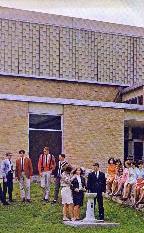 YELLOW BRICK ROAD
YELLOW BRICK ROAD
Crew from the Class of '67, out back of Ayer High (check out those skirts & ties). Me, far left, chatting up "Most Likely to Succeed" Curt; at the fountain, John Reardon; rising behind, our giant gymnasium
|
 DISTANT VISION
DISTANT VISION
St John's Chapel, Groton School; FDR's alma mater, founded 1884 by the Rev Endicott Peabody |
An American Education
School
Primary, secondary; public -- & exemplary
Gentry though they were, the Maxants and the Moores sent their kids to public schools. Ruth and I were in Ayer High's renowned A Cappella Choir. She was also in the band, on bassoon; I'd done French horn but didn't make the cut.
It was Ruth who fixed in my mind that "Where were you" moment no American then conscious can forget. It was on a shortcut home from school: a lane off Washington Street by the big shingle style house where lived my young Uncle Clarence, Aunt Janet and many Titus cousins I babysat (Doug, Michael, Steve, more to come; one grew up gay, if not the one I'd guessed), past the Mayflower Winslows to a path through some woods, down to the top of Taft Street.
There, Ruth stopped me one November afternoon and said: "President Kennedy has been shot."
The Bebouts, Rakips, Blacks, the Laggises (dad local haberdasher, another family buisness), the Wises and the Hamiltons, all went to public schools too. If the Cornelliers just for high school, St Mary's Parochial before; we grew up knowing who was Catholic -- or, as my grandmother sometimes said, "Micks." We had occasional rock fights with the Cornellier kids, just across Pearl; theology was not precisely at issue, but it did colour things in that town.
Most of them, even the Blacks, didn't have much choice. We'd all been through Pleasant Street Elementary -- a woman behind the cafeteria counter there often calling me Clarence; my gym teacher, Uncle Jerry Millson, suggesting I not call him uncle. Then to the new Page School, fifth through eighth grade.
North from there we could see giant earth movers carving a field of the Eliades farm into fit ground for a new, vast -- and mostly Army funded -- high school, junior and senior. I'd be there for ninth grade, one of 1,200 kids roaming halls so sprawling -- many wings, some two storeyed, of yellow brick and big windows -- that, at first, we needed maps.
When I reached 11th grade, Dick and Ellie Bebout did, suddenly, have a choice beyond public school. At least for one of their kids.
For some years from the age of eight I shared a room with two brothers. (After Brian, born in 1960, was old enough the oldest of us, Bill and I, swapped for what had been his nursery.) It was over the kitchen, a window with a long view north, past the Maxant's small white stable, fields between and behind to a green ridge, a Gothic tower rising in the distance over the trees.
Well, revived Gothic: it was the chapel of Groton School. Franklin Roosevelt, among others, has been there. And at our church, teaching Sunday School -- as Dorothy Maddox, wife of rector Henry, once recalled in choir practice. "Father Maddox," as Henry liked to be called, was English, perhaps hoping to take St Andrew's a bit more Anglican than some New Englanders might desire.
My grandmother, poor but proud, had picked St Andrew's when she and Ernest moved to Ayer, more for a certain caché, I imagine, than theology. It might have been the Federated Church -- Methodists, Congregationalists, maybe even Baptists -- big and white up on Washington Street.
I had been to Groton School, if not as one of its 300 or so students. After my father left G V Moore he had a series of small businesses, one called Home Kleen. Much of its work was what the ever moving Army called "clearing quarters." But Groton was, in its way, a home -- and a very nice contract, too. I did floors there.
There was another fine school in Groton, also Episcopal: Lawrence Academy. I had been there too, if just once, I think in 1961, outside and with half the town -- waiting to see Efram Zimbalist Jr (if, damn, not co-star Lana Turner) stroll out from under a Georgian (style) portico and down a walk, cameras catching him for the film, By Love Possessed. It had been a novel, by Grace Metalious, best known for a more scandalous New England town, Peyton Place.
Lawrence Academy, like Groton,was just for boys (I think, both co-ed now; but in those days such things could go without saying). Five years after Efram's Kleigl lit stroll, some people had plans to send this boy in through the door by which he had made his elegant exit.
Through what good offices I can't be sure, my parents were encouraged to try getting me into Lawrence Academy for my last two years of high school. Perhaps it was Donn Brown, a younger reverend who'd joined Father Maddox, nearing retirement, at St Andrew's -- apparently impressed with me. I was, after all, an Episcopal Young Churchman.
I seemed the perfect candidate: ever near the top of my class, as ever a Very Good Boy, one of the working class worthy of a leg up. I'd even been a brainy quiz show kid, pudgy and horn rimmed, on WBZ TV's "Science Countdown 1963." I'd swept Middlesex County, then the semi finals, on the final round coming in fourth in the Commonwealth. I won a bicycle and a toy weather station.
I was perhaps more impressed at being chauffeured to Boston by WBZ's celebrity weatherman Norm MacDonald, who lived in Groton. Lesley Gore's It's My Party was big then; on the car radio it seemed my song.
My PSAT and SAT scores (the 12th grade Scholastic Aptitude Test and its 11th grade Preliminary, those famous fate shaping hurdles) would be in the top ten percent for math, top three for "verbal." I would graduate fifth in a class of 200.
But none of that happened at Lawrence Academy. I stayed a student of Ayer Junior Senior High. I don't recall exactly what went down. My mother remembers Father Maddox getting snooty about it, a bit of Who Do You Think You Are. Maybe that had something to do with it.
Anyway, it didn't get me down. I'd never much liked the idea -- if feeling that, given the chance to "better" myself, I'd be nearly obliged to take it up.
And, to be grateful for it.
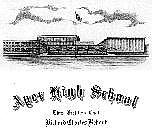 MY ALMA MATER (PUBLIC)
MY ALMA MATER (PUBLIC)
Ayer High (hardly all of it), on my diploma; gym rising at the back, auditorium (hall of thespian wonders), right.
LITTLE NORBIE'S TOO
Norbert Wiener (1894-1964), pioneer of cybernetics -- the science of feedback loops, automated systems, hence the computer -- was sent to Ayer High as a boy by his father Leo, a professor of Slavic languages at Harvard University, then living just south in the town of Harvard.
For Wiener's brief tales of Ayer (Miss Leavitt featuring, & local druggist Frank Brown, his store still there in my time, descendant Nancy, AHS Class of '67, behind the counter) see his Ex-Prodigy: My Childhood & Youth, MIT Press, 1964. |
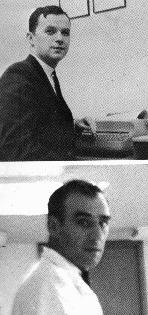 KING ARTHUR;
KING ARTHUR;
JOE THE SCIENCE GUY Barry McNiff, out of costume; Joe Freitas caught holding a seminar
|
Nothing was too good for the Future Leaders of the Free World. And hey, maybe even the local kids, lucky enough to be along for the ride.
There were well appointed, well stocked science labs. Audio Visual services (I was in the AV Club). A bright, huge gymnasium (two basketball courts) with lots of athletic hardware. There was Varsity and JV basketball, boys and girls; the Panthers: a 34 member football team fully decked out, coaches Don Scullane and Eustace Erickson driving them on -- Erickson with: "You're Weak, Weak, Weak!"
There was a newspaper (The Ayerald) a yearbook (Heirloom), a good library (Ida Naparstek a real librarian, before at Ayer's beautiful public one); clubs for math, chemistry, library aids, future teachers (if not Future Homemakers, or Farmers, of America); for Spanish, Latin, French; for bowling, skiing, and of course Pep. There was the band. The A Cappella Choir.
Most wondrous, in my life, was the auditorium -- officially the Laura S Leavitt Auditorium. Miss Leavitt had taught Latin, even did "Latin Fashion Shows," among her students a boy she liked dandling on her knee: Norbert Wiener. Little Norbie, child prodigy, was Ayer's sole claim to fame -- if born in Missouri and living then in Harvard: he'd become the Father of Cybernetics.
We didn't much mention Miss Leavitt. And the word "auditorium" barely suggests the scale and potential of that space. It was in fact a 1,200 seat professional theatre, grandly equipped.
Its stage was huge, deep, well sprung; the tall fly tower above hung with lighting trestles, scrims, drop flats, even a fly winch; an autumn gold curtain, vast, soft, and heavy, draped the proscenium. The stage wings, and the entire floor below, served as backstage. There was a decent sound system, good acoustics. And a lighting control panel then the best there was: an array of plug boards, levers, and switches standing taller than I and maybe eight feet wide, running banks of Kliegls, spots, washes, some gelled; colour rows, racks of back lights.
Much of that light power was high up and way back, in the canted, multi plane ceiling suspended over those 1,200 (padded, flip up, and multicoloured) seats. To get there you had to climb a wall ladder, two storeys up, to a small trap door. No, not you: I -- in terror the first few times.
I came to love being high up on those hidden catwalks.
I was caught up in two big musicals. In Camelot, 1965, I got to drag my Latin teacher Barry McNiff -- if in tights as King Arthur, temporarily supine -- on stage by a leg. (Barry was spiff: drove a little red sports car, once cracking it up; even the rakish head scar was spiff. He'd marry the brilliantly butch girls' gym teacher.)
In 1966 we did Anthony Newley's The Roar of the Greasepaint, The Smell of the Crowd, packing the house three nights running. Our crowd didn't smell, but may have wondered at their kids doing the Class Struggle -- via Broadway and British music hall, pure Dickens: toffs ever screwing proles; one literally knocked up (if off stage). Sex was the scandal; Americans rarely "get" class. It was bits of Brit lingo I didn't get then: kippers? claret? Even curry.
Director Jack Carton once, sitting back in that vast hall as I ran lights for a rehearsal, bellowed out -- at a slow, romantic full blackout cue I was fumbling, not having all the levers locked in synch -- "Bebout! What the hell are you doing! Haven't you ever had a girlfriend?"
I had not -- if, just briefly, a bit turned on by Bev Rakip. She was compact, short cropped, athletic; well... butch. Boyish. I never let on. At least I hope not.
I had had sex: a boy noted, unnamed, in Promiscuous Affections who didn't mind (not at all, really) being done. Even as he just stood there -- in my face, blatantly on offer -- I hardly minded oblige. (Hell, I was thrilled.) That boy who, of course, later got married.
I was tempted otherwise. Sometimes sorely, on my knees at that backstage light panel, by what big brash fellow techie Eugene Dancause had at eye level. Maybe on offer. Once in the lunch line he'd directed a joke at me, a fist cupped to my mouth: "Blow in this." I did; he grinned. "You're hired."
On our way home one night, late, after rehearsal, I decided to test his jocular repartee (even though it wasn't, in the moment, exactly on point). "What do you want, Eugene! I'll do anything!" I was play acting. Joking -- but not. We were in a field just off Pleasant Street, in the dark. I imploring. On my knees.
We didn't. I hadn't actually got his joke; I doubt he got mine. But he did laugh.
 ON TOP OF THE WORLD
ON TOP OF THE WORLD
Shot (my note on the back says) from the Swiss Sky Ride, New York World's Fair, 1965, there singing with Ayer High's A Cappella Choir; my first -- of just two -- brief trips to New York, this one taking us to Broadway, I think for Barefoot in the Park
|
It was the discipline. We made those costumes, built those sets, "Diction!" "Teeth!" painted big on the back of stageside flats. The backdrop for Greasepaint was long scrims, each dyed one of, as "There is a Beautiful Land" had it, "the colours of the rainbow sky." Hung separately. The fire marshall said they had to be fire proofed, sprayed; they'd shrink, warp apart. Kids sat on ladders, for hours, stitching them all together.
In Choir we rehearsed songs for months. Jack Carton drove us, even scared us. Once when, one too many times, we'd slurred past a crucial rest in Brahms' Ein Deutches Requiem, he reddened, threw his baton arm up and roared: "Behold -- REST!!!" -- his baton smashing down, snapping in half on his music stand.
We never missed it again. ("Behold -- all flesh is as the grass.") We learned to love that piece -- hugely difficult, almost hatefully so at first: its tempo in parts painfully slow; its volumes from near whispers to roaring crescendos. It could take many, many seconds to get out that first, almost inaudible, slightly rising "Ble...ssed... they...." (Selig sind... but we sang it in English.)
We bored our parents with it, even to near need of requiem.
Mind you, we did give them Broadway too. "I Believe in You" -- sung to a mirror in How to Succeed in Business (Without Really Trying) -- was big: costumed in duds snappier than our usual robes and fully choreographed, we wowed 'em. To this day, on the rare occasion it spins in my mind (as now), the lyrics still come with dance cues.
With the Brahms requiem, though, we didn't care what anybody else thought. We knew it; we'd got it. We revered it. To this day, I still do.
Jack Carton demanded from each of those many of us (casts of, well, scores; 51 in Camelot, not counting chorus and crew) the very best we could do. A rehearsal schedule I've still got for Greasepaint reads near the end: "Full cast only. Leads are on call at our mutual convenience -- mostly mine." Then, for all of us, all caps, underlined: "DO NOT MAKE ANY PLANS FOR THE APRIL VACATION."
Demands indeed. But when you'd met them, when you'd done it -- you knew it was your best. You knew you were good. Maybe even great.
Weeks of work on those big shows, intense, engrossing; three wondrous nights on (or back) stage -- then on Monday we all had to go back to the real world. A few to teachers who had wearied of thespian truancy. On one of those Mondays, after Greasepaint, Bill McGrail, my reserved 11th grade home room teacher (all of 23 I think), gave me a funny look when I walked in.
Then, with a little smile, he said: "Gee. I'd been expecting a high school play."
 MATH, HISTORY, HARD WORK
MATH, HISTORY, HARD WORK
Dr Chen; behind him Don Russell (not smoking) in the teachers' room
See my Public Spirit report of wild radicalism at AHS, led by its honor students, in Punditry: At seventeen.
|
|
YEARBOOK SHOTS
|
 JV CHEERLEADER 1967;
JV CHEERLEADER 1967;
HOMECOMING QUEEN, 1969 My sister Debbie (or as she later had it, Debi) front & centre; boyfriends I also got -- to see, anyway
All photos above (but for Pleasant Street & Groton chapel) from Heirloom '67
|
Joe Freitas was one: MS, University of Washington; BS, Fitchburg State; AHS Class of '50 something (so the older one: down near my grandparent's, its football field in the town park's bowl). He taught science, in my senior year Advanced Biology, a special course loosely structured. The class was small, pratically hand picked.
It was the closest I'd ever see to a seminar, then or later. A colloquium. A think tank. Joe (of course we called him Mr Freitas) was the first person to make me see science not as "facts," but as theories, assumptions, guesses -- standing ready to be proven wrong. In fact not science at all if closed to further scrutiny.
That one PhD was K Y Chen; Kwang Yung I think. Dr Chen, it was said, had been high in the Nationalist Chinese government. He taught math. I was in his senior class in calculus and analytic geometry. I had never worked so hard, or done so poorly.
Dr Chen's firmness was genial, his mere presence a form of moral suasion. He gave me Cs, in my last term a D. My only one, ever, the lowest grade in my entire educational career. And the best earned.
Don Russell and John Reardon opened my eyes to history. Don was a big brash man always smelling of cigarettes, smoked in the teachers' room with his younger buddies John Peralta and Dick Picucci, also teaching history, government -- and coaching football. Mr Russell was Head of Social Studies; he'd become Ayer High's principal.
John Reardon got two pages in Heirloom '67, its dedication: "Above all, Mr Reardon has shown that he cares about the students, and has a respect for their labors, their ideas, and their rights." After my family moved out of 66 Pearl Street, the Reardons moved in. On a trip back once I'd visit them there.
Tom Casey, another local boy, also respected our rights. He was advisor to the senior class, its leading lights a radically committed bunch -- even as the boys had to wear ties, the girls skirts that, when Assistant Principal Helen Haley forced them to kneel before her, had to touch the floor.
At a full school assembly held January 1967, the student council put forward eight proposals for "improved communication" -- faculty and admin types at all student council meetings; students at faculty and school board meetings; council facing the entire student body at least once every two months. Radical stuff.
The administration was rather taken aback -- particuarly when, at the end of that assembly, some 20 seniors decided not to leave that vast auditorium's plush seats. It made the local media -- as a "sit-in" of 150 angry kids.
I get these facts (and "facts") from The Public Spirit, my column there in fact born of that event. The first two installments were headed "A.H.S. Viewpoint." Not later. If I wasn't going to toe the line and let Principal Don Griffin (his family ran a variety store) vet my copy, I couldn't use Ayer High's acronym.
I made it "Student Viewpoint."
Tom Casey got some of us together and warned we watch our backs: there was buzz that we -- Ayer High's too bright lights, among us Student Council President Amy Snyder and a good chunk of its National Honor Society (we were dangerous: we had special "honor" hall passes that let us wander at will) -- might be expelled. Later that afternoon, changing for my janitor's job, I put on The Rolling Stones -- Ruby Tuesday -- and danced around my room in glee.
We weren't expelled. But I felt at last a true member of -- as The Who then had it -- "My Generation." (And hey: "The Kids Are Alright.")
Ayer High wasn't just that hugely useful building; not even those truly great teachers. What made it the best school one could find, for miles around, was the kids. Lots of them, in wondrous variety. As I said in Promiscuous Affections:
- "In those pretty little towns around us, kids sat in class with their next door neighbours. Around me from the 1st grade were kids who had lived in Stuttgart, Okinawa, even -- as one little 3rd grader told us in show & tell -- 'New Found Land.' They were a smart, socially skilled lot, most of them. They had to be: every three years or so they were uprooted and shipped off someplace new. They had learned to find their feet quickly."
Sometimes, even, to find them again. In 6th grade or thereabouts I had a buddy, Billy O'Donnell. He lived on the short stretch of Pleasant Street that dead ended north of Taft, in a house near the Black's new one (having moved all of a block), if more modest. Red haired, smallish, lots of fun. Then, as usual, he was gone.
He was back for high school. It took me ages to recognize him: big, lumbering; on the football team. We didn't, on that second round, much hang out together.
Even if on the scene just a few years (high school took only four), lots of Army kids were key players. And not just on the football team. Charlotte Ammons, brassy daughter of a drill sergeant and Ayer High's cheeringest cheerleader, is all over the yearbook, voted -- with John "Nimbo" Strata -- Most Talkative.
Colonel Snyder's Amy was, as we've seen, council president. She would go on to Bennington. We had lots of friends at the Fort -- getting to see how the Army's differing ranks lived: sergeants not quite like colonels. And Army kids, as Billy had, also lived nearby.
There were kids named Cebollero, Garcia, Diaz, Hernandez (three of them: Carmen, Class of '67, Pedro and Ernesto coming up behind her, '68 and '69 and gorgeous). "Cutest couple" Charlie Davis and Linda Wright were black.
My mother, the family later moved to the polite Worcester suburb of West Boylston, once scandalized a neighbour by asking, "Where are all the black kids?"
Those Army brats could put the local kids in the shade. Sometimes. Of the Class of '67's top five, only Amy was one; Pat Briggs and Pam Farnsworth were girls next door, from the town of Shirley. Amy did get chosen Most Likely to Succeed -- along with Shirley's Curt Brockelman, a butcher's son I think, also one of five "Class Favorites."
Margaret Hudlin lived on "Dump Road." Well, unofficially, nice enough in part if indeed leading to the town dump. I was there a few times: Margaret and I were best buddies.
She was a post Vatican II radical Catholic; she'd later wed a priest, clearly renegade, from St Mary's. On graduation night, after she'd given her valedictory speech in the auditorium, I found her in the music room nearby. She was nervous, throwing on her coat. "I've got to get out of here."
I knew why. A draft had been vetted by demi head honcho Helen Haley; Margaret had spoken to another text entirely. Mrs Haley, dozing, had bolted upright in the front row, clawing her chair's arms in clear -- if at last impotent -- rage.
There were local kids born Boulanger, Boisseau, Doiron, Langlois, grandchildren, or great, of Québécois(e) who'd made new lives in the mill towns of New England -- if becoming Bellangers, Buzzoos, Doyruns and Langlowises.
And the Saball kids. They could get away with anything. Dad was police chief of Shirley.
And, of course, there were beautiful boys. Richard Aborjaily, Class of '66 but then in Greasepaint as "The Kid," sidekick to "Sir," a role played on Broadway by a girl. No girl Richard, if often called "Applejelly." His torso (I got to see him in the dressing room) had most marvellous contours, skin the colour of sandalwood. He was easy, funny, sly. Even with kids still in the 11th grade.
Tracy Emerick: not beautiful really, just big for his age and very hot: he liked going on about the girls he'd got on that Choir trip to New York. Braggadocio maybe. But I liked to imagine his equipment in action, familiar with its play in the shower: Tracy liked to beat his crotch to a froth and dickwhip suds at smaller boys -- impressed with his spunk (so to speak) if trying not to catch any.
Doug Grow: that incredible nose unbent from brow to tip, the straw head; the voice, as "Cocky," that no one (but Jack Carton) imagined he had. But we weren't close, I just a backstage (if not football) fan.
Jeff Lancaster, Celt skinned, his torso trim, long; we were close: lots of time in his room or out on our bikes, I always trying to ride behind him, for the view. I didn't get him. His Baptist mother did, sending him to Bob Jones University.
Smouldering sexy bad boy Clark Pierce, whom I saw get a book in the head from Barry McNiff in Latin class. And in his bedroom, in nothing but his briefs.
We didn't. Our connection, so unlikely, was wonder enough.
My sister Debbie did much better with cute boys. Two years behind me, she was an AHS JV cheerleader, later Varsity. Few of her boyfriends played football, most too small: Steve ("Skosh") Snyder, younger brother to Amy, skinny, smart, bespectacled; eager little Paul Dickhalt (said "dick out"; I'm not sure a "boyfriend" but I certainly noticed him).
And Martin Beck. The only theatre known to those Becks was the one of war: a statue of Marty's father, high ranking Green Beret, stood at Fort Devens. Beck the Younger hoped to drag Debbie off to West Point. My sister knew better. In 1969 she would be Homecoming Queen.
Ours was Kathy Sullivan; King, Dick O'Toole: not a football player but the smart, quiet, fine boned son of a local mortician. I knew Kathy, but not as well as one of her courtly entourage: Cathy Cahill.
We were odd buddies too: we even swapped class rings. They were initialed inside, RCB and CMC. So we each made up a name to match: Renée Charisa Barron and Cedric Michael Courde. Imagine. I'm glad we never had kids.
I never had any trouble with football players. In part, I think, because I filled one of high school's classic, expected -- even respected -- roles: the egghead. The brainy kid; the one always picked last for anything in gym. But, you know, pretty much okay.
Sure, I might have coveted genial Curt's title of Most Likely to Succeed. But that sort of honour is always bestowed on those widely found "well rounded." I, inevitably, got Most Studious. With Margaret Hudlin.
But there was more to it than that: I was confidante to some of those football players' girlfriends.
I once sat at the light board during Greasepaint with another smart Snyder, Sue, as she went on about Denny Lyons -- footballer extraordinare (both he and she Class of '66) -- if in the moment playing Anthony Newley's "Sir" to fellow football star Doug's "Cocky." Sue was doing costumes.
It was a rehearsal, no costumes yet. Denny came off stage in a jersey, and gridiron underwear laced up the front. Sue looked down. I too. Denny, a bit embarassed, said: "Well, there is something under there." Fabric, he meant. Sue and I smiled. At each other.
I don't know what, or whom, I missed by not having prepped, all boy, for the Ivy League. And, I hardly need tell you, I don't care.
Next: Politics: Partisan; & the politics of education
Go back to An American Education / Introduction
This page: http://www.rbebout.com/me/ahs.htm
February 2001 / Last revised: October 5, 2001
Rick Bébout © 2001 / rick@rbebout.com
 HIGH TO ELEMENTARY
HIGH TO ELEMENTARY
 DEFENDER
DEFENDER
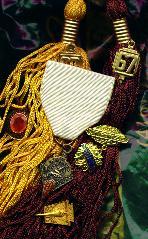 "HONOR" RELICS
"HONOR" RELICS
 "Be the labor great or small,
"Be the labor great or small,
 "Wit & judgement
"Wit & judgement
 "Mischief & humor are
"Mischief & humor are
 "Life is a jest & all things show it"
"Life is a jest & all things show it"
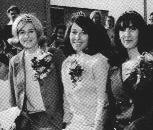 DEMI QUEENS
DEMI QUEENS